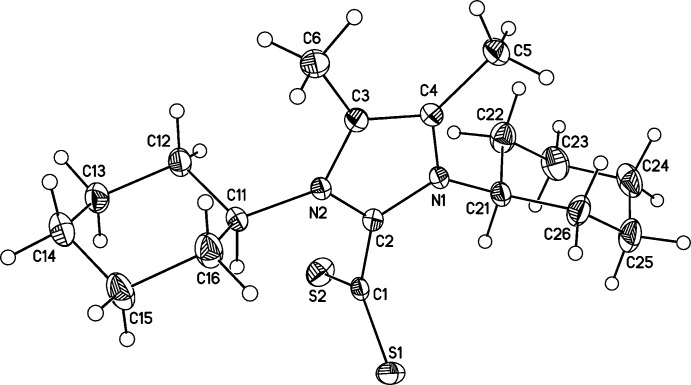1,3-二环己基-4,5-二甲基- 1h -咪唑-3-ium-2-碳硫盐氯化物单溶剂的晶体结构。
IF 0.9
Acta crystallographica. Section E, Structure reports online
Pub Date : 2014-11-05
eCollection Date: 2014-12-01
DOI:10.1107/S1600536814023800
引用次数: 0
摘要
标题化合物C18H28N2S2·CHCl3结晶为两性离子。C-S债券几乎相等,长度分别为1.666(3)和1.657 (3)Å。S-C-S键角扩展到129.54(16)°,N-C-N键角减小到四面体值108.8(2)°。在晶体中,相邻的分子通过C-H⋯S氢键连接,沿着[100]形成链。氯型溶剂分子在两个位置上无序[占比= 0.51(2):0.49(2)],通过分叉的C-H⋯(S,S)氢键与链相连。本文章由计算机程序翻译,如有差异,请以英文原文为准。



Crystal structure of 1,3-di-cyclo-hexyl-4,5-dimethyl-1H-imidazol-3-ium-2-carbodi-thio-ate chloro-form monosolvate.
The title compound, C18H28N2S2·CHCl3, crystallizes as a zwitterion. The C-S bonds are almost equivalent, with lengths of 1.666 (3) and 1.657 (3) Å. The S-C-S bond angle is expanded to 129.54 (16)° and the N-C-N angle is reduced to the tetra-hedal value of 108.8 (2)°. In the crystal, adjacent mol-ecules are linked via C-H⋯S hydrogen bonds, forming chains along [100]. The chloro-form solvent mol-ecule, which is disordered over two positions [occupancy ratio = 0.51 (2):0.49 (2)], is linked to the chain by bifurcated C-H⋯(S,S) hydrogen bonds.
求助全文
通过发布文献求助,成功后即可免费获取论文全文。
去求助
来源期刊
自引率
33.30%
发文量
0
审稿时长
1.3 months
期刊介绍:
Acta Crystallographica Section E: Structure Reports Online is the IUCr highly popular open-access structural journal. It provides a simple and easily accessible publication mechanism for the growing number of inorganic, metal-organic and organic crystal structure determinations. The electronic submission, validation, refereeing and publication facilities of the journal ensure very rapid and high-quality publication, whilst key indicators and validation reports provide measures of structural reliability. In 2009, the journal published over 4000 structures. The average publication time is less than one month.

 求助内容:
求助内容: 应助结果提醒方式:
应助结果提醒方式:


